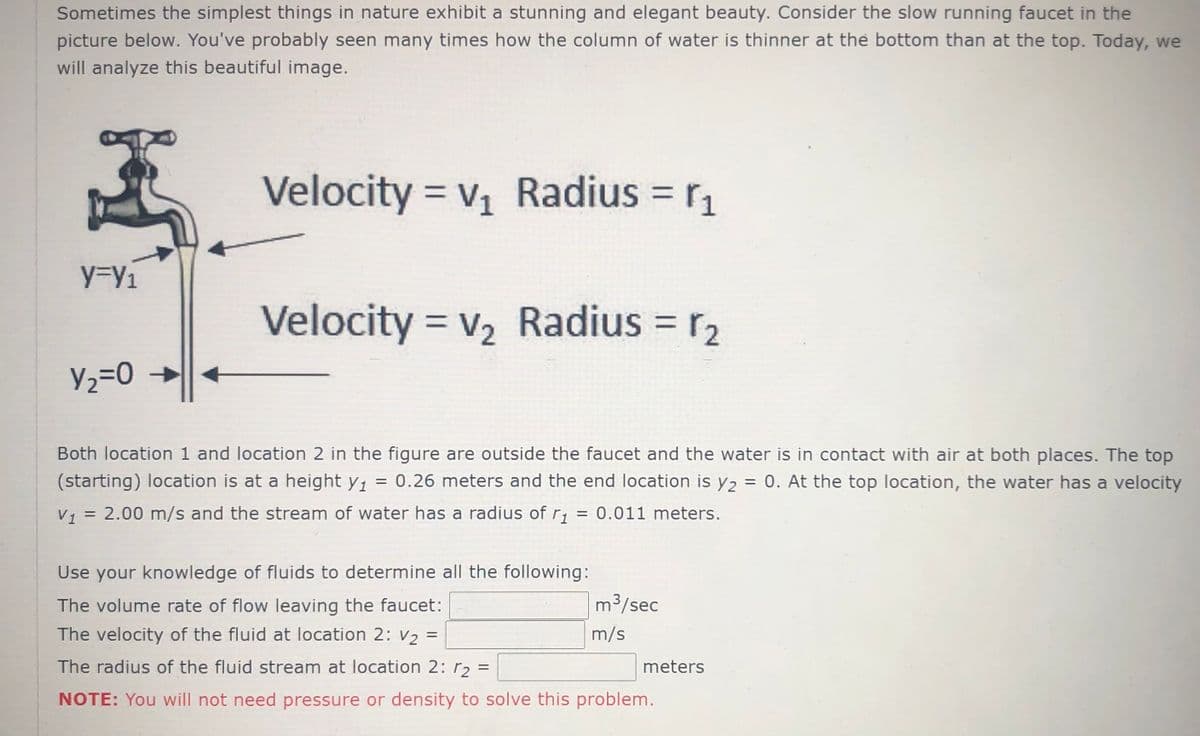Sometimes the simplest things in nature exhibit a stunning and elegant beauty. Consider the slow running faucet in the picture below. You've probably seen many times how the column of water is thinner at the bottom than at the top. Today, we will analyze this beautiful image. Velocity = V1 Radius r1 %3D y=Y1 Velocity = v2 Radius = r2 %3D V2=0 > Both location 1 and location 2 in the figure are outside the faucet and the water is in contact with air at both places. The top (starting) location is at a height y1 = 0.26 meters and the end location is y2 = 0. At the top location, the water has a velocity
Sometimes the simplest things in nature exhibit a stunning and elegant beauty. Consider the slow running faucet in the picture below. You've probably seen many times how the column of water is thinner at the bottom than at the top. Today, we will analyze this beautiful image. Velocity = V1 Radius r1 %3D y=Y1 Velocity = v2 Radius = r2 %3D V2=0 > Both location 1 and location 2 in the figure are outside the faucet and the water is in contact with air at both places. The top (starting) location is at a height y1 = 0.26 meters and the end location is y2 = 0. At the top location, the water has a velocity
Elements Of Electromagnetics
7th Edition
ISBN:9780190698614
Author:Sadiku, Matthew N. O.
Publisher:Sadiku, Matthew N. O.
ChapterMA: Math Assessment
Section: Chapter Questions
Problem 1.1MA
Related questions
Question

Transcribed Image Text:Sometimes the simplest things in nature exhibit a stunning and elegant beauty. Consider the slow running faucet in the
picture below. You've probably seen many times how the column of water is thinner at the bottom than at the top. Today, we
will analyze this beautiful image.
Velocity = V1
Radius = r1
y%3y1
Velocity = v, Radius = r2
V2=0
Both location 1 and location 2 in the figure are outside the faucet and the water is in contact with air at both places. The top
(starting) location is at a height y, = 0.26 meters and the end location is y2 = 0. At the top location, the water has a velocity
%3D
V, = 2.00 m/s and the stream of water has a radius of r; = 0.011 meters.
Use your knowledge of fluids to determine all the following:
The volume rate of flow leaving the faucet:
m³/sec
The velocity of the fluid at location 2: V2 =
m/s
The radius of the fluid stream at location 2: r2 =
meters
NOTE: You will not need pressure or density to solve this problem.
Expert Solution
This question has been solved!
Explore an expertly crafted, step-by-step solution for a thorough understanding of key concepts.
This is a popular solution!
Trending now
This is a popular solution!
Step by step
Solved in 3 steps

Knowledge Booster
Learn more about
Need a deep-dive on the concept behind this application? Look no further. Learn more about this topic, mechanical-engineering and related others by exploring similar questions and additional content below.Recommended textbooks for you

Elements Of Electromagnetics
Mechanical Engineering
ISBN:
9780190698614
Author:
Sadiku, Matthew N. O.
Publisher:
Oxford University Press

Mechanics of Materials (10th Edition)
Mechanical Engineering
ISBN:
9780134319650
Author:
Russell C. Hibbeler
Publisher:
PEARSON

Thermodynamics: An Engineering Approach
Mechanical Engineering
ISBN:
9781259822674
Author:
Yunus A. Cengel Dr., Michael A. Boles
Publisher:
McGraw-Hill Education

Elements Of Electromagnetics
Mechanical Engineering
ISBN:
9780190698614
Author:
Sadiku, Matthew N. O.
Publisher:
Oxford University Press

Mechanics of Materials (10th Edition)
Mechanical Engineering
ISBN:
9780134319650
Author:
Russell C. Hibbeler
Publisher:
PEARSON

Thermodynamics: An Engineering Approach
Mechanical Engineering
ISBN:
9781259822674
Author:
Yunus A. Cengel Dr., Michael A. Boles
Publisher:
McGraw-Hill Education

Control Systems Engineering
Mechanical Engineering
ISBN:
9781118170519
Author:
Norman S. Nise
Publisher:
WILEY

Mechanics of Materials (MindTap Course List)
Mechanical Engineering
ISBN:
9781337093347
Author:
Barry J. Goodno, James M. Gere
Publisher:
Cengage Learning

Engineering Mechanics: Statics
Mechanical Engineering
ISBN:
9781118807330
Author:
James L. Meriam, L. G. Kraige, J. N. Bolton
Publisher:
WILEY